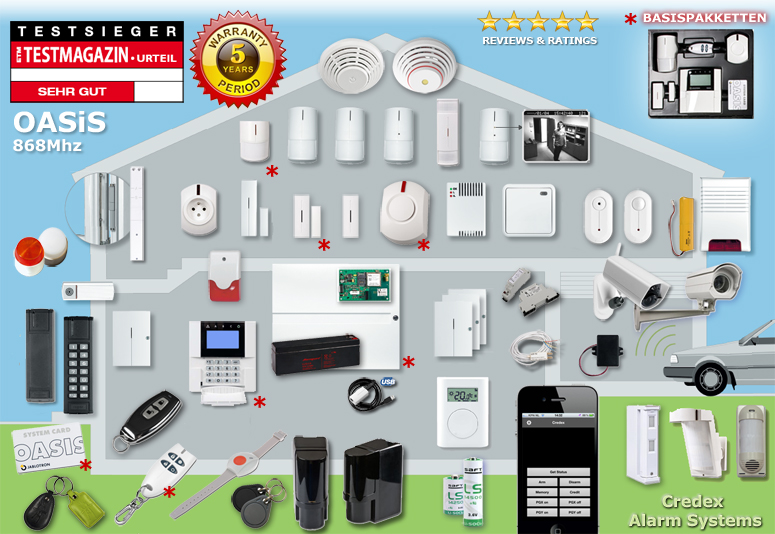Jablotron OASiS 80
Jablotron OASiS 80 - Selection Overview
|
|
||
| * = standard components of a Jablotron OASiS starter-kit. Select any component for the product page. |
Jablotron OASiS is a kit from which a personalised system can be easily customised. Similar in concept to the popular Profi system, but using a more modern wireless encrypted 868MHz protocol. The devices have a longer communication range (300m) and the antennas are not visible, its batteries have a longer life (± 3 years) and in general a more modern design.
The OASiS is suitable for both residential areas as well as shops, offices, stores, workshops, etc. It can report theft, fire, flooding, frost risk, the risk of overheating, health problems, intrusion and other possible risks. The system has the option of a unique wireless motion detector with a built-in stills camera. It sends the alarm images to mobile phones and PC's. It makes visible what is really happening at your place.
Jablotron OASiS also allows you access control: opens electric locks, garage doors, gates, etc.. This is possible by entering a numeric code, by presenting a reader with an RFID chip in a card / key-fob, or a remote control. The system also offers home automation, e.g. remote control of appliances, heating control, switching appliances with (motion) detectors or remote controls.
Jablotron OASiS Configuration
Protecting a car near the systemThe compact mini-size detectors of the OASiS system can also protect a car (cars) parked in the proximity of the house. The mini-sized car detectors can be assigned to their own dedicated section in the system. The control panel however, routinely checks the wireless communication of its devices. If communication with a particular device is lost for two hours, the control panel can report a fault indication. In the OASiS system, communication is checked every 9 mins. The mini-sized detectors have the option to disable radio communication supervision by internal dip-switches. It allows car detectors to be excluded from supervision to avoid alarm triggering when driving the car away from the system.
|
| |
|
|

Final-door function
In this mode, up to 5 detectors can be defined as final-door detectors in order to make leaving a building much easier, especially via a garage. If a final-door detector is used in the system then this detector can be programmed to extend the exit- or entrance delay. This mode is unsuitable for pulse detectors such as JA-80P motion detectors. If a final-door detector is triggered during the exit delay, the exit delay will be extended by the time in which the detector is still triggered. So, if for example, the door is left continuously open, the exit delay will never end.
Bypass User Approval
This setting can change the function of the system when it is being armed and if there is: any detector triggered, any tamper alarm, any trouble in the power source, lost communication with any wireless device (for more than 20 minutes) or any panic button triggered. If bypass user approval is set, then during arming, the system notes which problems mentioned above are active and displays informative text on the keypad and only bypasses them if the user approves the bypassing.
Social Alarm Feature
If this function is enabled the signals from delayed, next delayed and instant detectors are regularly checked in disarmed mode. If there is no active signal (no movement inside) for more than 16 hours a panic alarm is triggered.
Automatic Setting / Unsetting
This can be used to program an automatic sequence of daily setting/unsetting events (timer). Up to 10 daily events can be programmed. Events will occur every day of the week.
...AND MANY MORE!




